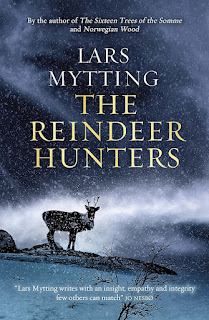The Reindeer Hunters - Lars Mytting
The Reindeer Hunters is the second book in the Lar Mytting's Sister Bells trilogy, so don't read on unless you have read the first book, The Bell in the Lake.
The second book in the trilogy opens in 1903, over twenty years after the events recounted in The Bell in the Lake. The previous book ended with the pregnant Astrid Hekne seeking to leave the small frozen village farming community of Butangen in the far north of Norway, seeking to fulfill a dream of seeing more of the wider world that had been open up to her by the visit of a German architect, Gerhard Schönauer, who had come to the village to dismantle the village's traditional medieval stave church for transportation and rebuilding in Dresden.
Astrid however has died during childbirth, giving birth to twins. Guilty over the fact that his actions may have contributed to Astrid's untimely death, the pastor Kai Schweigaard brings one child Jehans back to Butangen, believing that only one of them has survived. The fate of Astrid and his mystical experiences with the famous Henke bells has caused him to have doubts about his faith and he will not relent until he understands that her death has had some purpose. He tries to honour her final wishes by searching for the fabled Hekne Weave, created by the conjoined Hekne sisters in early 1600s, a terrifying creation supposedly depicting the end of the world.
Despite Astrid's ambitions and education she never managed to get far from Butangen and neither, it seems will Jehans. He has been raised to the age of 15 by the pastor only to see him return to the bosom of the Hekne family when he learned of the role Schweigaard played in his mother and father's fates. Jehans feels bound to the land, to the mystery of the bell in the lake, to the tradition and pull of the past. And, not insignificantly, he has a debt to pay off in farming work to the current lord and master of Hekner, Osvald.
Paying off that debt obliges Jehans to hunt reindeer and it's while hunting, using an old rifle, that he comes into contact with another outsider, an English hunter Victor Harrison. Both he and the pastor recognise in the Englishman an uncanny likeness to Jehans' father, Gerhard Schönauer, and they have to accept the undeniable fact that they must be brothers, twins. The importance of two 'chain' Hekne brothers to the Hekne mythology is known to pastor, who hopes to atone for his mistakes with regard to Astrid by raising the sister bell from Lake Løsnes, separated from its sister bell in the tower of the Bugangen stave church now rebuilt in Dresden.
As well as carrying on the legacy and unfulfilled desires of their mother and father, Jehans and Victor (and the continued search for the fabled Hekne Weave that seems to forge a link between the past and the future) also fulfil the role of Mytting's apparent aim to use the trilogy as a means of exploring the development of Butangen and by extension Norway into a modern nation. Jehans' interest in engineering makes progress not seen in the remote Northern village, bringing electricity to the community and taking them a little into the 20th century. Through his wife, there is also small but significant progress made in the role of women. None of this is easily achieved and involves a lot of hard work and painful choices.
The progress into the modern world seems slower in The Reindeer Hunters, but that's because rather than leaving behind the superstitions and traditional beliefs of the past, Mytting takes time to explore those roots and deepen an understanding of what has given rise to current beliefs and attitudes, which often conflict with any progress being made. In a few places he takes that back long before Astrid, back to the time of the famous conjoined Hekne sisters in the early 17th century, and further into Norse times highlighting connections that exist between Norway and Scotland. The broader question of a definition of Norway coming into itself as a nation with its own identity, one that can reach back into history and define itself outside of the Union with Sweden is also touched upon.
If it's slower going it seems as if Mytting feels that Norway isn't quite ready yet to go out into the wider world, as Astrid longed for, until it faces up to and comes to terms with its past. In some ways there's already a wider world all there in the history and tradition of the people, in the myths, traditions and stories. There are fewer surprises then in this second volume of the Sister Bells trilogy, and the new bearers of the Hekne name and tradition don't seem to make quite as much of an impression as Astrid in The Bell in the Lake, but that impression can be deceptive. The progress into the 20th century however is significant, The Reindeer Hunters closing in 1919, following the Great War and and the ravages of the Spanish flu pandemic. Nothing will ever be the same again.
Reading notes: The Reindeer Hunters: The Sister Bells Trilogy Vol. 2 by Lars Mytting, translated by Deborah Dawkin is published by MacLehose Press on 3rd March 2022. Reviewed from advance proof copy provided by publisher.




Comments
Post a Comment